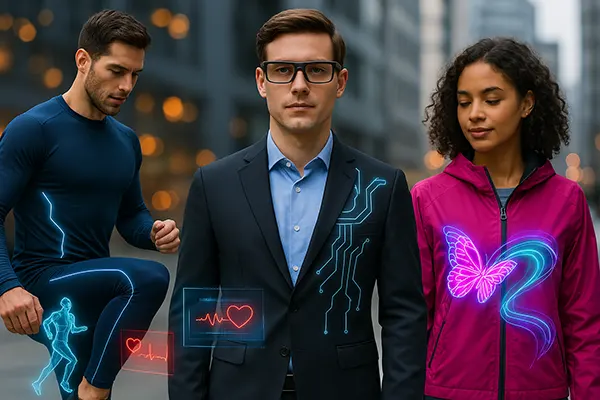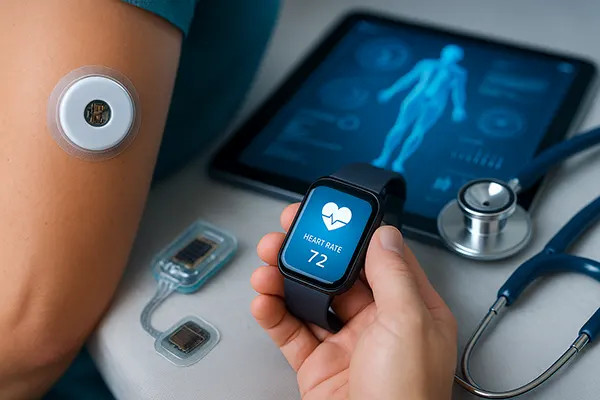
Smart Fabrics and Augmented Reality Clothing: A New Era in Fashion Tech
Fashion is evolving far beyond aesthetics, embracing cutting-edge technologies that redefine the role of clothing in everyday life. One of the most fascinating directions is the integration of augmented reality (AR) into smart fabrics. From enhancing athletic performance to revolutionising business attire, the fusion of AR and textiles is shaping a new era in fashion technology.
Wearable Innovation: How AR is Transforming Sportswear
Sportswear is no longer limited to comfort and breathability. In 2025, augmented reality is pushing the boundaries of what athletic clothing can offer. Companies like Asensei and Nadi X have embedded sensors into garments that work with AR to offer real-time coaching through apps or smart glasses, correcting posture or movements during workouts. This technology is becoming especially popular among solo athletes or home fitness enthusiasts.
Smart fabrics equipped with haptic feedback allow athletes to feel vibrations that guide their form, eliminating the need for constant screen monitoring. These features improve performance while preventing injuries by teaching correct movement patterns in real-time. Many AR systems also provide live statistics—like heart rate, flexibility range, or stress points—via integrated displays or companion apps.
Beyond individual sports, team-based training is also benefiting. Some AR-compatible uniforms now offer situational simulations, visualising strategies or drills directly on the athlete’s gear through smart visors. These innovations streamline training routines and enhance communication between coaches and players.
Key Players and Current Products
Several tech companies are leading the AR sportswear charge. The aforementioned Asensei, in collaboration with sports brands, launched AR-powered leggings that provide yoga posture correction. Meanwhile, Athos and Xenoma develop electromyography (EMG)-based smart shirts that offer full-body motion analysis. These products are widely used in rehabilitation, physiotherapy, and high-performance athletic programmes.
Brands like Nike and Adidas are also exploring AR overlays integrated into their running shoes and gear. In early 2025, Adidas released a limited edition of smart jerseys that display live metrics, visible through AR glasses. While still niche, these products signal a growing mainstream interest.
The convergence of fitness, fashion, and augmented reality presents a high-growth opportunity, with smart sportswear projected to be a $7 billion industry by the end of 2025. The growing accessibility of AR wearables, including Meta and Apple Vision Pro devices, only accelerates adoption.
Augmented Officewear: Enhancing Business Fashion with AR
Corporate dress codes are being rewritten with technology in mind. Smart suits and blouses now include AR interfaces that support real-time communication, biometric tracking, and interactive presentations. In 2025, this trend is especially visible in sectors like tech, healthcare, and education, where dynamic clothing adds functionality to formal attire.
Augmented reality fabrics can link with mobile or wearable devices to overlay contextual data, such as meeting notes or speaker bios, visible only to the wearer through smart glasses. This capability enhances productivity without disrupting etiquette in formal settings. In addition, biometric sensors monitor stress or temperature, helping wearers regulate their comfort and well-being.
Some smart garments are also capable of changing colour or pattern via AR projection based on mood, lighting conditions, or meeting type. This gives professionals new tools for self-expression and adaptability while maintaining a polished look.
Adoption in Enterprise Environments
Companies like Google, Apple, and Lenovo are already piloting AR-compatible uniforms in corporate offices. A notable example is AR-powered name tags sewn into jackets, which link to a wearer’s LinkedIn profile or project team through a simple gesture. This eliminates the need for physical introductions in networking events or conferences.
Samsung’s SmartSuit prototype, currently in trial across several tech expos, allows users to control presentation slides or access cloud data through fabric-based gesture controls. These developments demonstrate that AR officewear is no longer conceptual—it’s becoming part of the corporate toolkit.
Startups such as Wearable X and Loomia are also contributing by focusing on fashion-forward, AR-integrated businesswear that doesn’t compromise on style. Their designs blend traditional tailoring with responsive fabrics that interact seamlessly with AR software.

Everyday Fashion Meets Augmented Reality
Beyond the realms of sport and business, AR-enhanced fabrics are making waves in casual and streetwear fashion. Brands are introducing clothing items that interact with AR apps to unlock digital designs, personalised styling tips, or virtual try-ons. For instance, scanning a jacket with a mobile device can project holographic accessories or animation effects tailored to the wearer’s tastes.
These interactive garments encourage consumer engagement and customisation, making fashion more personal and playful. Major high street retailers, such as Zara and Uniqlo, now experiment with collections that include AR layers, transforming everyday items into digital canvases for expression.
Eco-conscious fashion is also joining the AR movement. Smart labels made from biodegradable materials can now display sustainability data or garment lifecycle information when viewed through AR. This transparency appeals to younger, environmentally aware consumers demanding accountability from brands.
Fashion Shows and Retail Integration
Fashion weeks in London, Paris, and Tokyo in 2025 have already embraced AR fashion. Runway shows feature models whose outfits are enhanced by AR effects visible through audience smartphones or AR glasses. These experiences offer designers new ways to showcase seasonal narratives and innovation.
Retailers are also enhancing the shopping experience with AR garments. Fitting rooms are increasingly replaced by smart mirrors or apps that allow users to preview how different fabrics or cuts would appear on them in real-time. This reduces returns and enhances customer satisfaction.
Luxury brands such as Gucci and Burberry lead the AR revolution in high-end fashion, offering limited-edition pieces that unlock digital-only content, such as NFTs or AR environments, fostering exclusivity and collector interest.




